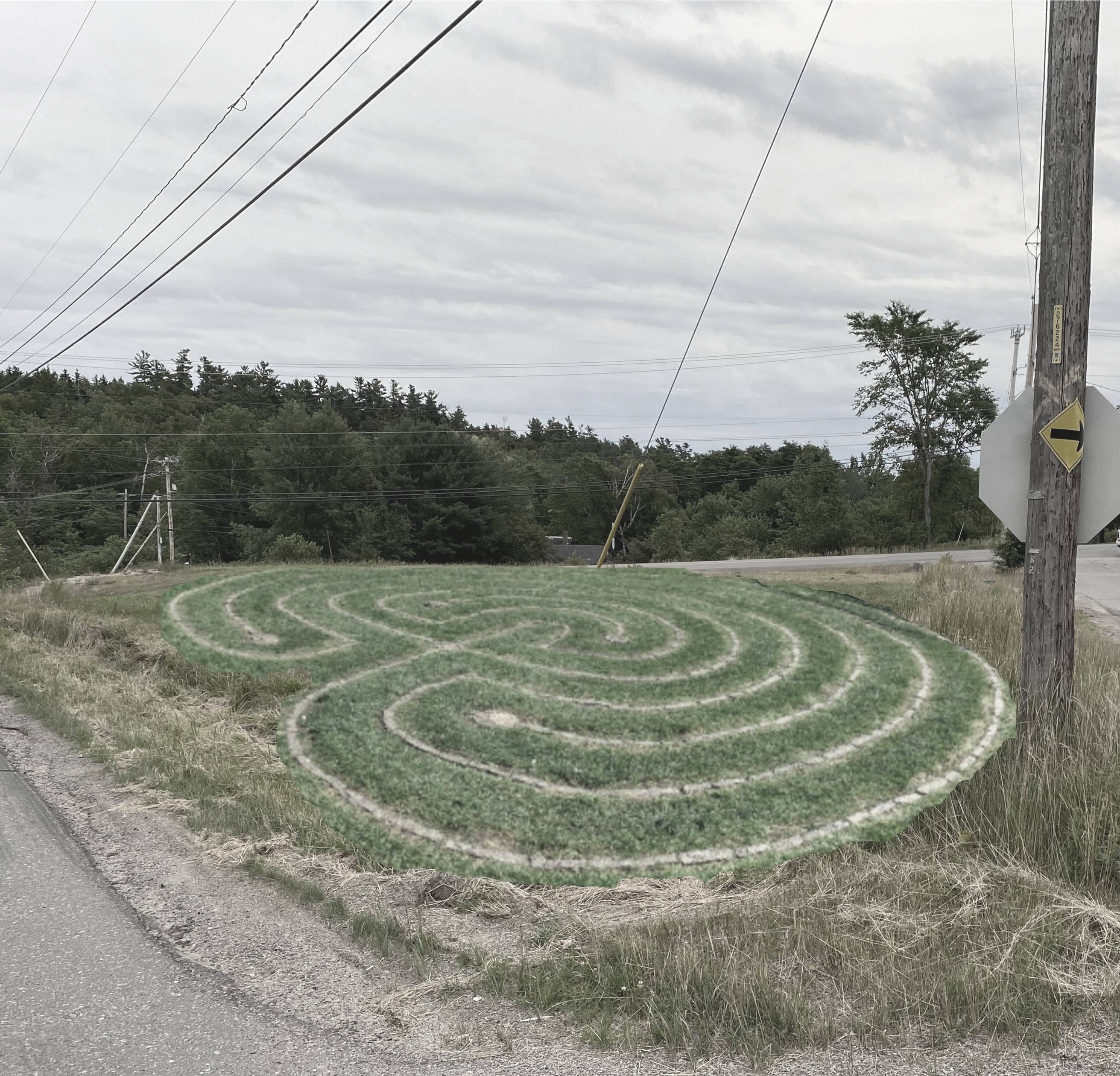About Stephanie

Stephanie Garon's environmental art investigates humanity's interruption of nature. Power. Natural objects juxtaposed against industrial materials reference history, science, and culture to convey themes of claim, labor, and time.
Stephanie is a Trawick Art Prize winner, Hamiltonian Fellow, a National Park Service AIR in the Everglades, and grant recipient from the Puffin Foundation Environmental Art, Foundation for Contemporary Arts, Lucid Art Foundation, Maine Humanities… more
Sculpture
My sculpture brings natural materials into the gallery space to investigate humanity's interruption of the environment. Natural materials are hand sourced at each specific site and all steel sculpture is fabricated by me to address themes of claim, labor and permanence.
I've worked with teams of scientists, indigenous tribes, lawyers, activists, and community members on cultural, historical, scientific, and economic issues surrounding a mine in Maine/Passamaquoddy land. I was invited by Smithereen Farm in Pembroke, Maine to create large scale artworks using 20,000 rock core samples to amplify these perspectives as part of the Maine Clean Water campaign. Five surrounding towns and two reservations depend upon clean water for their economy, health, & environment. The body of artwork was exhibited at The Kreeger Museum (Washington, DC), Hamiltonian Gallery, MICA, and Alchemy of Art Gallery and will travel for the next two years to sites including Stand4 Gallery (Brooklyn), The Parsonage Gallery (Maine) and University of Southern Maine in 2024.
-
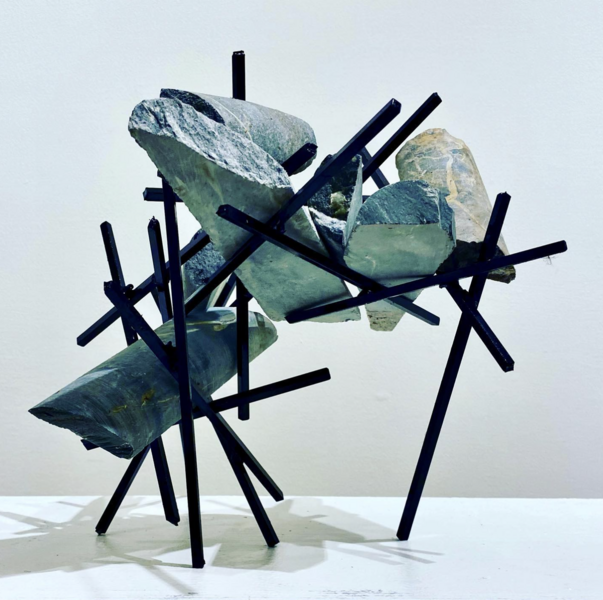 AssumptionAssumption: Steel, mined rock cores from Maine/Passamaquoddy land 1'x1'x1'
AssumptionAssumption: Steel, mined rock cores from Maine/Passamaquoddy land 1'x1'x1' -
 SaySteel, mica schist 24”x24”x12” Claim and permanence of natural resources are underlying themes of my works of art on mining. With more than 300 active mines in the Baltimore-DC region, on indigenous land, I wonder if we will Say mine Say yours Say stop Say time Say cheese Say anything
SaySteel, mica schist 24”x24”x12” Claim and permanence of natural resources are underlying themes of my works of art on mining. With more than 300 active mines in the Baltimore-DC region, on indigenous land, I wonder if we will Say mine Say yours Say stop Say time Say cheese Say anything -
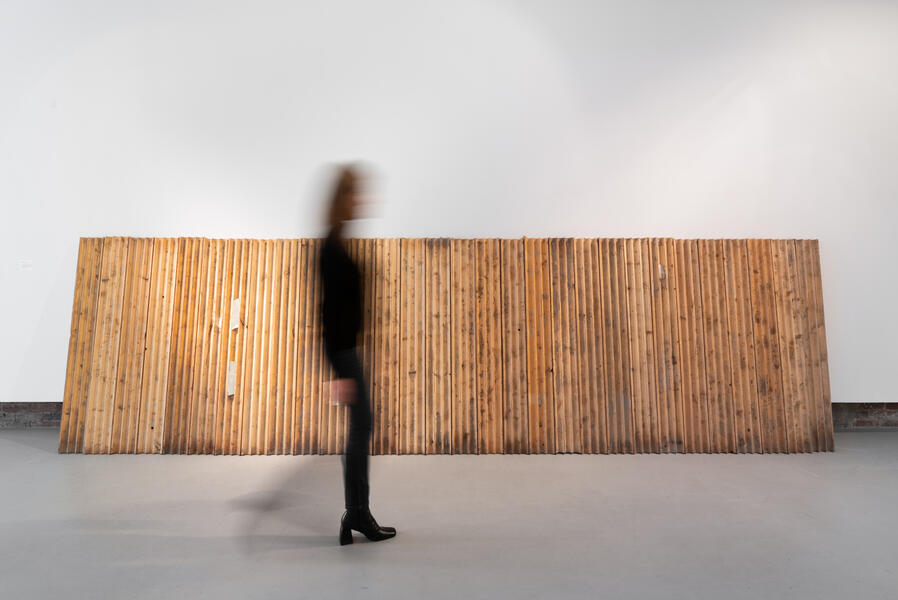 ShaftedShafted Hand carved wood 5'x16'x3' Trays that hold and store mined cores were historically hand carved from wood, an artistry unto itself. The Maine cores were stored in hundreds of these trays. In modern mining practice, the trays are made of plastic.
ShaftedShafted Hand carved wood 5'x16'x3' Trays that hold and store mined cores were historically hand carved from wood, an artistry unto itself. The Maine cores were stored in hundreds of these trays. In modern mining practice, the trays are made of plastic. -
03_Garon_Succession.JPEG
Steel, glass, silver maple leaves
6’x6’x12
Silver maple leaves came from six trees used in a climate change experiment. Data from the experiment inspired an app that monitored and protected global forest loss.
-
BraeBrae: Steel, cypress tree. 10'x10'x8' (As shown at Brentwood Arts Exchange 2021)
-
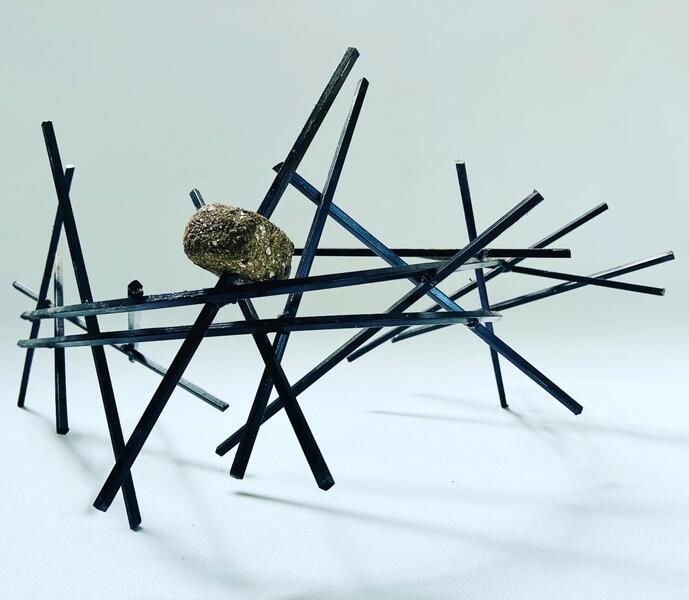 Queen
QueenSteel, wild clay sourced from reclaimed oyster shells in collaboration with The Billion Oyster Project NYC.
12"x20"x12"
-
ImpalpableImpalpable: steel, felled red oak, enamel 96"x72"x36" (As shown at Hemphill Gallery 2021)
-
 PreyPrey: Steel, oak 8'x6'x4' (As shown at Culture House 2021)
PreyPrey: Steel, oak 8'x6'x4' (As shown at Culture House 2021) -
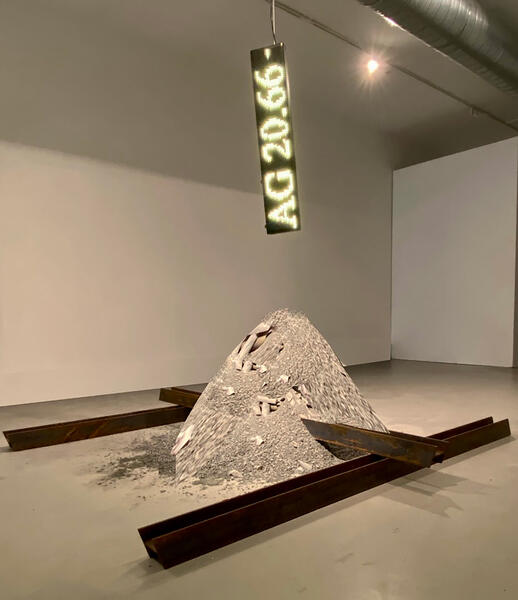 Gold RushGold Rush: Steel I-beams, mined rock cores, LED ticker Gold Rush uses rock cores previously extracted from a mine to examine the ecological, cultural, and social implications of mining Indigenous land. An LED ticker displays weekly stock prices for gold, silver and copper to emphasize the commodification of natural resources.
Gold RushGold Rush: Steel I-beams, mined rock cores, LED ticker Gold Rush uses rock cores previously extracted from a mine to examine the ecological, cultural, and social implications of mining Indigenous land. An LED ticker displays weekly stock prices for gold, silver and copper to emphasize the commodification of natural resources. -
 VoidVoid II: Extracted mine cores from Maine/Passamaquoddy land 10'x10'x3' (As shown at The Kreeger Museum)
VoidVoid II: Extracted mine cores from Maine/Passamaquoddy land 10'x10'x3' (As shown at The Kreeger Museum)
Installation
My installations are site specific explorations that examine the tenuous, dynamic relationship between nature and humanity. Viewers physically navigate their path and their connections to nature in site specific installations that incorporate sculpture, video, and sound.
-
PryPry, a site specific installation at Washington College, investigates humanity's interruption of nature. Climate change ields more invasive species, like the acres of phragmites bordering the Chester River. Indoor installation: steel, phragmites sourced from Chester River, single channel video, sound (24'x24'x14') Outdoor installation: steel (14'x14'x7')
-
HoverHover: steel, prunus cerasus tree, cherries, projection 12'x13'x10' Sound by Clint Sleeper By presenting nontraditional materials, like a suspended cherry tree and its fallen cherries, within a gallery space, Hover captures the ideals of the Arte Povera movement. Surrounded by steel sculptures, the audience witnesses the decomposition of the natural elements juxtaposed against the industrial materials through the duration of the exhibit. Hover investigates themes of claim, women's labor, and permanence.
-
Breaking GroundWait Loblolly pine needles, video projection (4:53 loop) Site specific installation Sound by Clint Sleeper 2021 Breaking Ground, a site specific full room installation at Washington DC's Honfleur Gallery, explores humanity’s connection to nature in an urban setting and features 200 cubic feet of loblolly pine needles. An immersive, ecologically motivated intervention by humanity, Breaking Ground transplants locally sourced Loblolly pine needles into an interior gallery space. By following the Arte Povera movement, the installation questions the use of nontraditional materials as art and humanity's connection to them. Pine needles change placement, emphasizing the fragility of nature. Rich in associations, the work functions as abstracted expressions of a time, place, and way of life. The resulting artwork is a visualization of an uneasy truce: the fragile balance between nature and humanity.
-
 usm3.jpg
usm3.jpgUnder/Current: steel, wild clay, wood mining trays, 7:28 single channel video filmed at low tide in Maine (Cobscook Bay near Pleasant Point Reservation). An area on Google Maps that’s colored grey since it marks indigenous land. Under/Current is a sculptural video installation that investigates space & impermanence through the perspective of the history, science, culture, and economy of mining.
-
Silent SpringSilent Spring, an immersive environmental installation at Motor House (12/1/20-2/1/21), explores humanity’s connection to the environment through a journey that is both an expedition and a contemplation. Rows of 1,000 prehistoric-sized Princess Tree leaves (Paulownia tomentosa) frame an ethereal leaf labyrinth. These leaves, classified as an invasive species of weeds, are typically found in soils hurt by construction or fire and frequently located in pavement cracks or by powerlines at the road’s edge. They grow 15 feet/year until smothering the canopy. All leaves were sourced from the Baltimore region over the course of one year. In Japan, it's customary to plant a Princess Tree when a girl is born. When she is eligible for marriage, the tree is cut down and carved for her dowry. Women and nature, around the world, intersect and are tied to issues of claim, commodity, and climate change. The labyrinth opens to two large I-beam steel armatures which hold two Princess Trees.
-
Lament IILament II: steel, pine/oak/maple tree branches 8'x23'x4' Women around the world, from Bangladesh to Benin, carry bundles of sticks to support their community. Confined by land and ritualistic roles, Lament references women's work. Lament II was curated for Washington DC's Foggy Bottom Biennial.
-
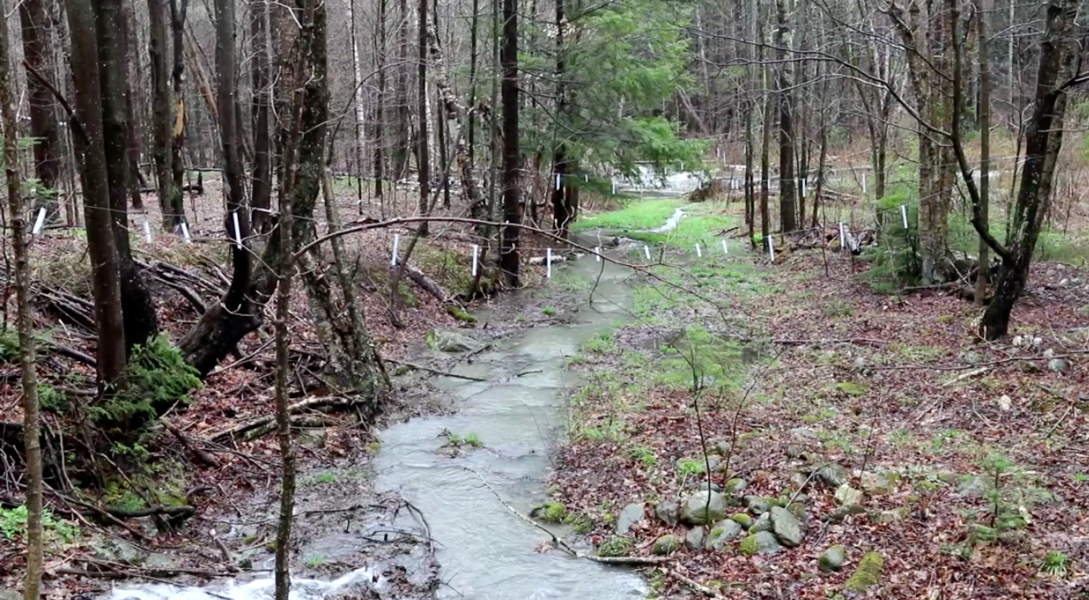 FathomFathom: sound art generated by Vermont's Mad River & Lincoln Brook’s force against 300 feet of steel & galvanized cable. Collaboration with Clint Sleeper. . Fathom, inspired by the unit of measurement of water depth, uses sound as the intersection of art & science. As we experience more storms from climate change, water agitates the steel to make sound.
FathomFathom: sound art generated by Vermont's Mad River & Lincoln Brook’s force against 300 feet of steel & galvanized cable. Collaboration with Clint Sleeper. . Fathom, inspired by the unit of measurement of water depth, uses sound as the intersection of art & science. As we experience more storms from climate change, water agitates the steel to make sound. -
 LamentLament: steel, oak/pine/maple sticks sourced from Maryland forests 14'x14'x8'. Women around the world, from Bangladesh to Benin, carry bundles of sticks to support their community. The sticks are used for shelter, cooking, and tool making. Confined by land and ritualistic roles, Lament references women's work and humanity's dependency on forests. With climate change and globally devastating wildfires, a single branch becomes sacred symbolism in a time of massive deforestation.
LamentLament: steel, oak/pine/maple sticks sourced from Maryland forests 14'x14'x8'. Women around the world, from Bangladesh to Benin, carry bundles of sticks to support their community. The sticks are used for shelter, cooking, and tool making. Confined by land and ritualistic roles, Lament references women's work and humanity's dependency on forests. With climate change and globally devastating wildfires, a single branch becomes sacred symbolism in a time of massive deforestation. -
FramedFramed: steel, white ash tree 4'x8'x4' (As shown at Studio 80 Sculpture Park)
-
TreadSteel, soil, glue 4'x6' Climate control, gravity, and time influence the artwork to decompose. Changes in the soil create a performance art as the movement of the soil puckers and landslides down the frame. As shown: day 4 at Creative Alliance's Organic Destruction exhibition.
Land Art
My land artworks explore humanity's interruption of the land through my movements. Installation works, performance art, sound and video are integrated into each piece. Thanks to a grant from The Puffin Foundation, I choreographed and performed three performances in conjunction with a series of three land art works to explore humanity's movement around nature.
Located at a section of Maryland's Patuxent River managed by a dam, the earthworks were submerged like many of the Mid-Atlantic prehistoric petrogyphs that were destroyed for hydroelectric projects. The public's view from the bridge transformed the digging process into performance art. A written and spoken word piece accompanies the series.
-
Land Art (Aerial view)Three large scale land artworks were created along the Patuxent River, Maryland, in an area that is controlled by a dam. This video contains the aerial footage for two artworks: Cusp (50') and Dig (500')
-
DigDig, an excerpt of a video documenting the creation of a 500' land art, is located at a section of the Patuxent River managed by a dam. When the dam reopens, the artwork gets submerged like many Mid-Atlantic prehistoric petroglyphs that were destroyed for hydroelectric projects. By exploring the interdependence between humanity and nature, this performance art and earthwork focus on impermanence.
-
 CuspCusp: shovel and hand carved portion of Patuxent River (Maryland) 50'. Cusp, the second in a land art series at a section of the Patuxent River that is managed by a dam, follows the shape of the shoreline and points towards the land's boundaries. By carving the land, like skin, the piece references loss and scarring by humanity. Over several months, the void filled with plastic bags, bottles, and receipts. When the dam reopens, the land art will be submerged. A spoken word piece accompanies the documentation of the earthwork.
CuspCusp: shovel and hand carved portion of Patuxent River (Maryland) 50'. Cusp, the second in a land art series at a section of the Patuxent River that is managed by a dam, follows the shape of the shoreline and points towards the land's boundaries. By carving the land, like skin, the piece references loss and scarring by humanity. Over several months, the void filled with plastic bags, bottles, and receipts. When the dam reopens, the land art will be submerged. A spoken word piece accompanies the documentation of the earthwork. -
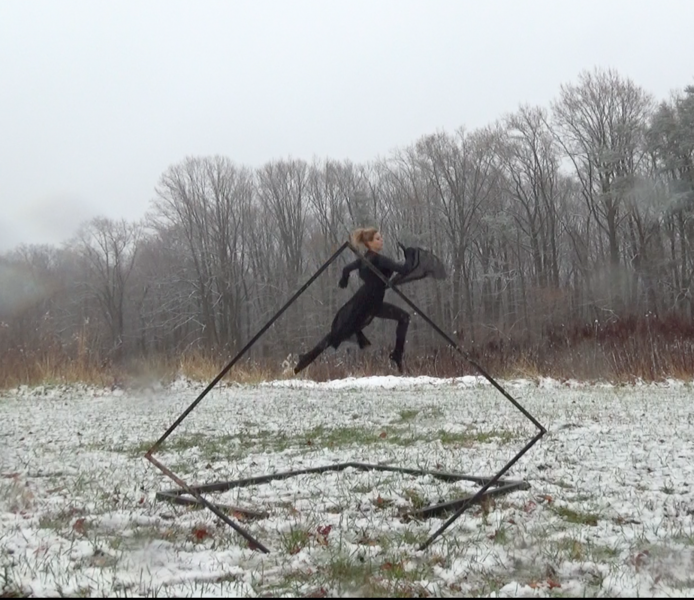 ParalyzedVideo still of land art performance containing steel sculpture at Maryland's Duckett Watershed (video 4:51). Choreography and dance by Stephanie Garon. Music: Paralyzed by NF. By personifying the land and exploring vulnerability through dance, the dancer's movements frame the relationship between humanity and nature. Although the watershed is a protected piece of government land, it is completely surrounded by new building developments that claimed centuries-old farmland.
ParalyzedVideo still of land art performance containing steel sculpture at Maryland's Duckett Watershed (video 4:51). Choreography and dance by Stephanie Garon. Music: Paralyzed by NF. By personifying the land and exploring vulnerability through dance, the dancer's movements frame the relationship between humanity and nature. Although the watershed is a protected piece of government land, it is completely surrounded by new building developments that claimed centuries-old farmland. -
 SurviveVideo still of land art performance containing steel sculpture and textiles at Maryland's Duckett Watershed (video 3:46). Choreography and dance by Stephanie Garon. Music: Survive by Diablo. By personifying the land and exploring vulnerability through dance, the dancer's movements frame the relationship between humanity and nature. Performed in the woods simultaneously as 4 million acres of trees burned in California's 2020 and 2021 wildfires.
SurviveVideo still of land art performance containing steel sculpture and textiles at Maryland's Duckett Watershed (video 3:46). Choreography and dance by Stephanie Garon. Music: Survive by Diablo. By personifying the land and exploring vulnerability through dance, the dancer's movements frame the relationship between humanity and nature. Performed in the woods simultaneously as 4 million acres of trees burned in California's 2020 and 2021 wildfires. -
 Silent SpringAs part of the public programming of the Silent Spring environmental art installation, this performance involved navigating paths around invasive species. Music by Clint Sleeper.
Silent SpringAs part of the public programming of the Silent Spring environmental art installation, this performance involved navigating paths around invasive species. Music by Clint Sleeper. -
Beginning, BecomingClip of Beginning, Becoming public performance at Honfleur Gallery Beginning, Becoming: by Christopher Stracey (6:05) Movements are drawings in pine needles. After research, sketches, sourcing, writing and conversations, my personal work culminates with wordless expression. My practice is built upon sculpture, but steps through nature and land help me understand form, perspective and permanence.
-
 Under/Current
Under/CurrentOriginal choreography and performance focused on land claim performed at the mining site.
Image taken at second performance at University of Southern Maine.
Poetry
Writing is a critical aspect of my artistic process. Written word serves as a companion to the themes of my sculptural work as I source local materials. After publishing in numerous international literary journals, my poetry collection was published by Baltimore-based Akinoga Press and translated into an audiobook. In 2020, I was honored to be a Writer-in-Residence with Baltimore's Yellow Arrow Publishing. In 2025, my next book, Feral, will be published by Akinoga Press.
-
Acreage: A Poetry CollectionAcreage is a published collection of 32 poems that speak to the vulnerability of nature to humanity. Over the past year, poems were published in eight international literary journals.
-
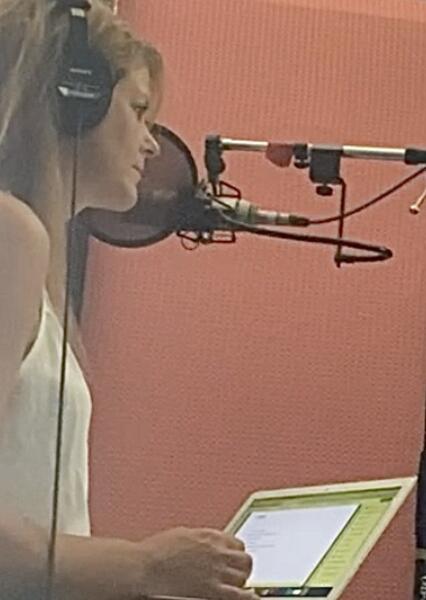 Acreage: The AudiobookBaltimore's Bentley Sound Studio mixed my voice, rain, oak seeds & more into professional tracks to record the audiobook version of Acreage.
Acreage: The AudiobookBaltimore's Bentley Sound Studio mixed my voice, rain, oak seeds & more into professional tracks to record the audiobook version of Acreage. -
 Yellow Arrow Writer-in-Residence
Yellow Arrow Writer-in-Residence -
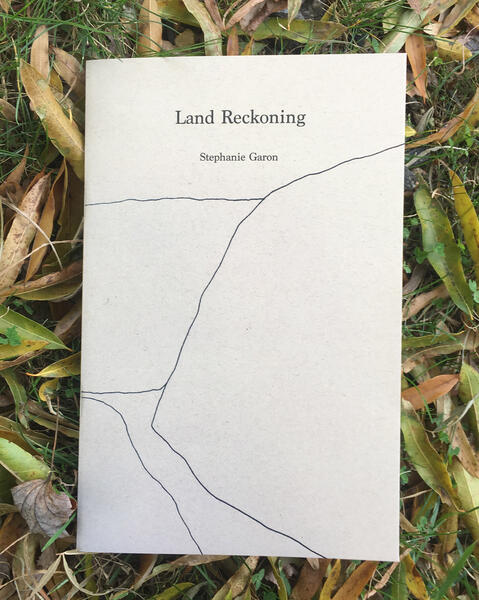 Land ReckoningLand Reckoning is the written companion to a series of three land artworks completed along the Patuxent River, Maryland. The chapbook is distributed next to the video documentation of the land art at gallery exhibitions.
Land ReckoningLand Reckoning is the written companion to a series of three land artworks completed along the Patuxent River, Maryland. The chapbook is distributed next to the video documentation of the land art at gallery exhibitions. -
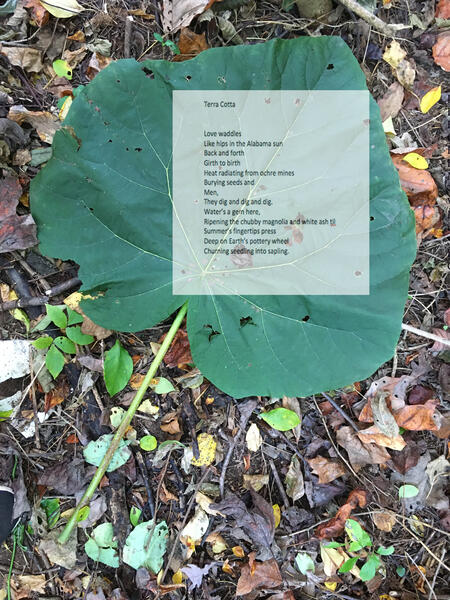 Terra CottaTerra Cotta was published in Resilience, a literary volume by Yellow Arrow Publishing.
Terra CottaTerra Cotta was published in Resilience, a literary volume by Yellow Arrow Publishing. -
 Relentless RainRelentless Rain is part of a collection of poems written as part of the process of sourcing materials for artworks. The collection was published by Baltimore based Akinoga Press.
Relentless RainRelentless Rain is part of a collection of poems written as part of the process of sourcing materials for artworks. The collection was published by Baltimore based Akinoga Press.
Works On Paper
To extract rock cores, mines clear 30 feet of trees to insert a 5" wide steel pipe for mechanical operations. These works on paper conceptually tie rock to paper, two critical natural resources. Pigments were made using crushed and ground rock cores, mixing them with DC tap water and natural binder, and juxtaposing them with rocks mixed with calcium hydroxide (lime), the primary chemical mines use for extractions.
-
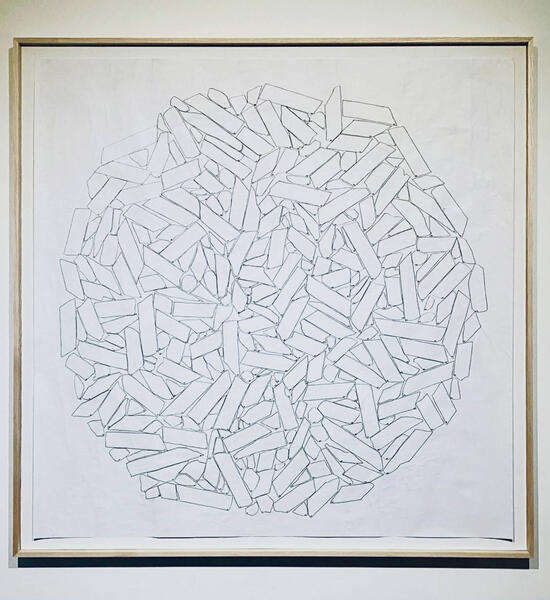 VoidVoid: Ink tracing of 324 mine cores from Maine/Passamaquoddy land removed 5'x5'
VoidVoid: Ink tracing of 324 mine cores from Maine/Passamaquoddy land removed 5'x5' -
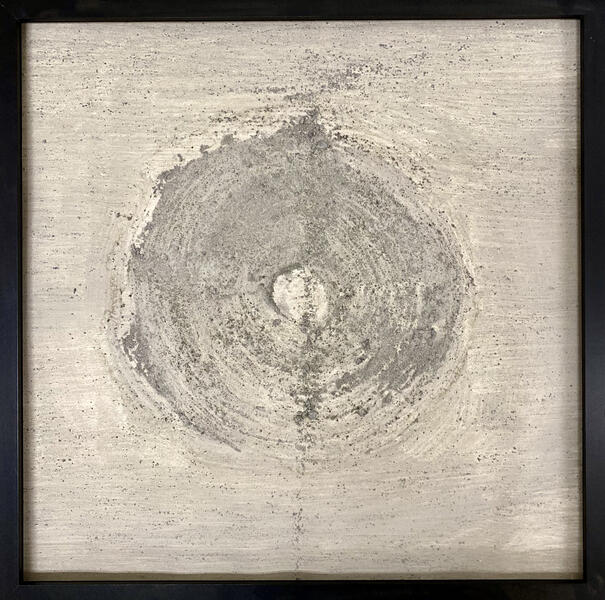 CoreCore Extracted mine core from Maine/Passamaquoddy land 36"x36"
CoreCore Extracted mine core from Maine/Passamaquoddy land 36"x36" -
 UntitledUntitled Extracted mine cores from Maine/Passamaquoddy land 48"x60' To extract rock cores, mines clear 30 feet of trees to insert a 5" wide steel pipe for mechanical operations. These works on paper conceptually tie rock to paper, two critical natural resources. Pigments were made using the cores and juxtaposing them with rocks mixed with calcium hydroxide (lime), the primary chemical mines use for extractions.
UntitledUntitled Extracted mine cores from Maine/Passamaquoddy land 48"x60' To extract rock cores, mines clear 30 feet of trees to insert a 5" wide steel pipe for mechanical operations. These works on paper conceptually tie rock to paper, two critical natural resources. Pigments were made using the cores and juxtaposing them with rocks mixed with calcium hydroxide (lime), the primary chemical mines use for extractions. -
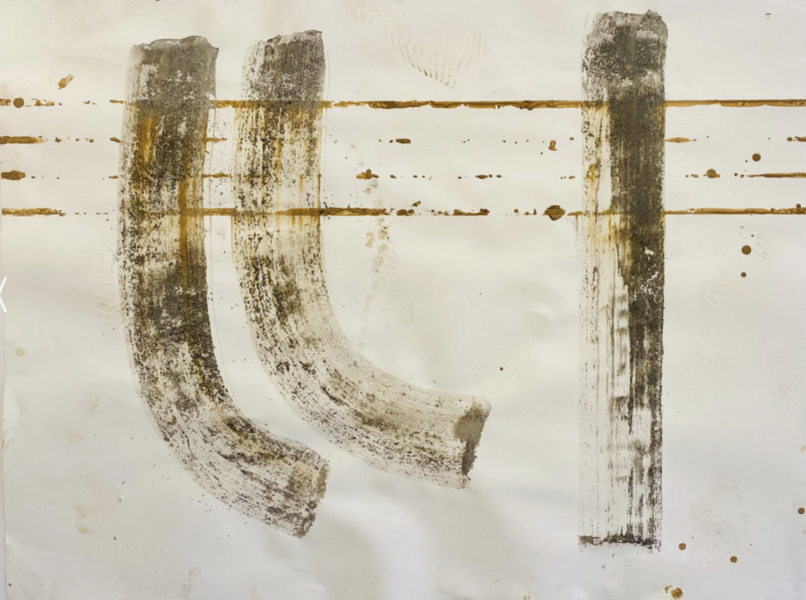 UntitledUntitled Extracted mine cores from Maine/Passamaquoddy land 48"x60"
UntitledUntitled Extracted mine cores from Maine/Passamaquoddy land 48"x60" -
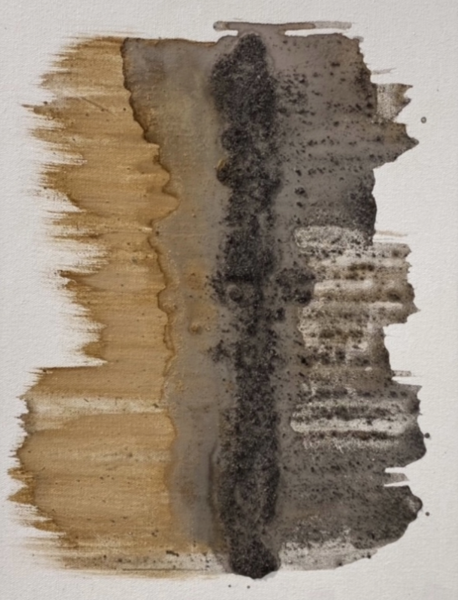 UntitledUntitled Extracted mine cores from Maine/Passamaquoddy land, Baltimore tap water, calcium hydroxide, soil 18"x24"
UntitledUntitled Extracted mine cores from Maine/Passamaquoddy land, Baltimore tap water, calcium hydroxide, soil 18"x24" -
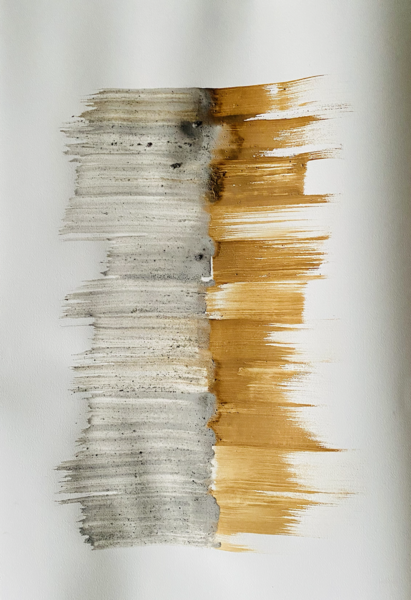 UntitledUntitled Extracted mine cores from Maine/Passamaquoddy land, Baltimore tap water, calcium hydroxide, soil 18"x24"
UntitledUntitled Extracted mine cores from Maine/Passamaquoddy land, Baltimore tap water, calcium hydroxide, soil 18"x24" -
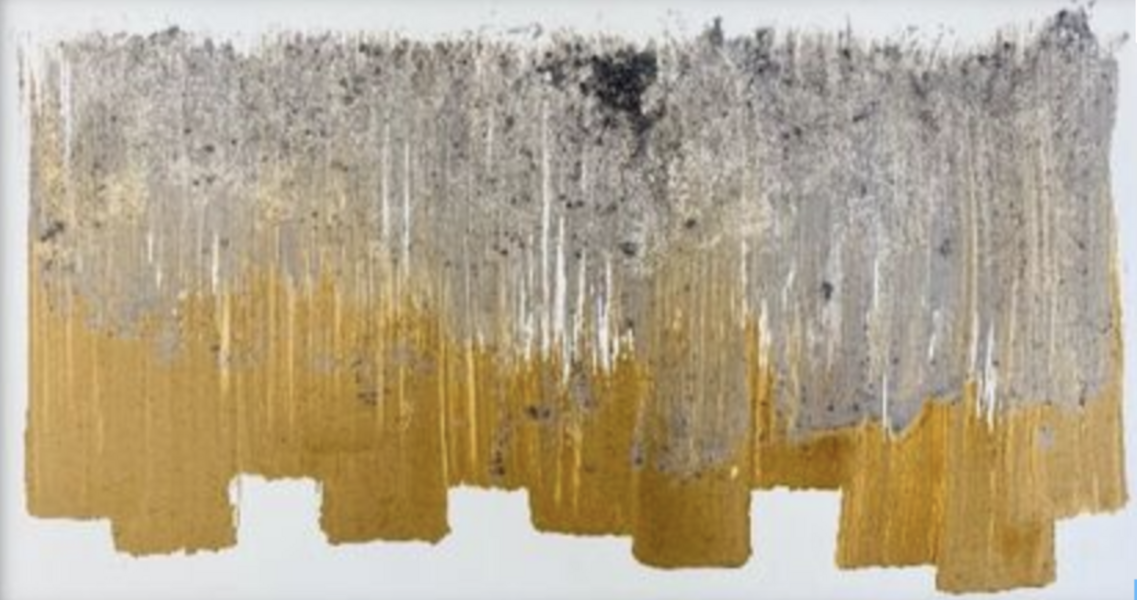 UntitledUntitled Extracted mine cores from Maine/Passamaquoddy land, Baltimore tap water, calcium hydroxide, soil 10"x18"
UntitledUntitled Extracted mine cores from Maine/Passamaquoddy land, Baltimore tap water, calcium hydroxide, soil 10"x18" -
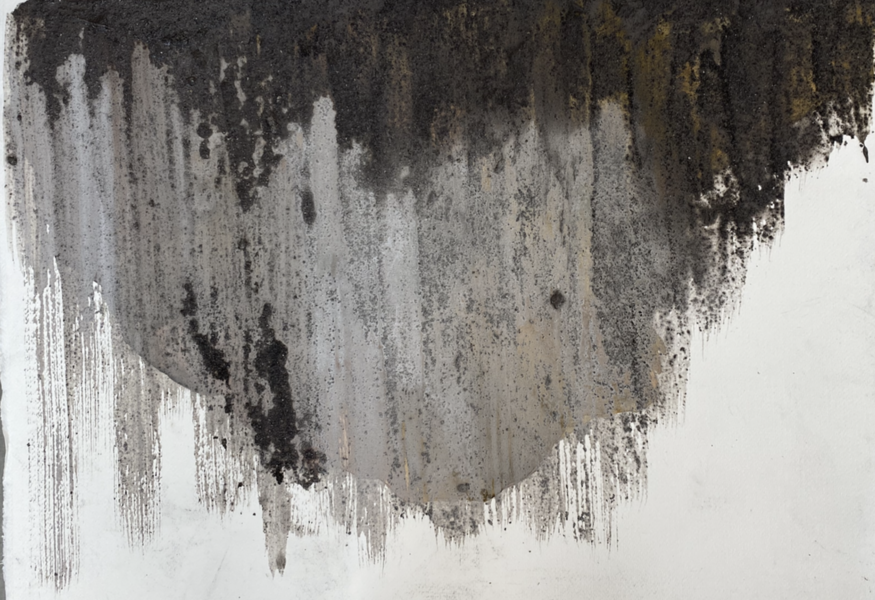 UntitledUntitled Extracted mine cores from Maine/Passamaquoddy land, Baltimore tap water, calcium hydroxide, soil 22"x26"
UntitledUntitled Extracted mine cores from Maine/Passamaquoddy land, Baltimore tap water, calcium hydroxide, soil 22"x26" -
ResonanceResonance: Ground mine cores from Passamaquoddy land, calcium hydroxide, DC tap water with sound collaboration with award winning folk musician Mali Obomsawin, Abenaki. 48"x120"
-
Bearing
Wood, mined rock cores from Maine/Passamaquoddy land, limestone, sandstone, wild clay
25 12”x12”x1”
The top mined natural resources on the east coast include: cement, salt, limestone, and crushed stone. This work on wood uses natural resources to consider how humanity claims, cultivates, divides, and utilizes natural resources.
Projects in Process
.
A mining company is attempting to reopen the mine in the town, where these original samples came from. Mines obliterate the water supply & surrounding environment, so the project is geared toward environmental justice. After researching mines and geology speaking with scientists from the Urban Soils Institute, learning from meetings with Passamaquoddy tribe members and exploring land and community on site in Pembroke, I am building a model for exploratory artworks that advocate for environmental justice.
The exhibition will have two parts: an outdoor, community based installation in the heart of Pembroke and a traveling gallery component.
Exhibitions include:
-Maryland Institute College of Art (June 2022) outdoor labyrinth
-Alchemy of Art Gallery (June 2022)
-Hamiltonian Gallery (DC) (December 2022)
-University of Southern Maine (January 2023)
Outdoor installation:
-Labyrinth at te main quad at MICA open to the community
-Labyrinth at the main Pembroke triangle open to the community
Northeastern Indigenous tribes consider labyrinths to be a means for humanity to connect to a source: when someone walks through, it's a gesture of gratitude to the earth. Since the rocks were taken from the land by the mining company, returning the rock to the soil would signify healing. At the center of town, this interactive installation would be at the heart of the community and pull people to the venues at the town center.
-
 Extracted Mining CoresMore than 20,000 mining cores were extracted from the earth 90 years ago at Big Hill, the mining site in Pembroke/Sipiyak, Maine. Stored on site at Smithereen Farms, these contain gold, silver, lead, and sulfur. The exact mineral composition impacts how much the current larger mining company, based in Canada, can sell stock.
Extracted Mining CoresMore than 20,000 mining cores were extracted from the earth 90 years ago at Big Hill, the mining site in Pembroke/Sipiyak, Maine. Stored on site at Smithereen Farms, these contain gold, silver, lead, and sulfur. The exact mineral composition impacts how much the current larger mining company, based in Canada, can sell stock. -
 Extracted Mining Cores: StorageThe 20,000 extracted mining cores are stored based on a system consistent with the U.S. Geological Service. By working with a multitude of scientists through the Urban Soil Institute, I have been able to better understand the political, financial, and aesthetic impact of the cores' compositions.
Extracted Mining Cores: StorageThe 20,000 extracted mining cores are stored based on a system consistent with the U.S. Geological Service. By working with a multitude of scientists through the Urban Soil Institute, I have been able to better understand the political, financial, and aesthetic impact of the cores' compositions. -
The Maine Core Sample ProjectThe Maine Core Sample Project uses video, photography, and large scale sculpture to investigate the impact of one mine on the small town of Pembroke, Maine. At the heart of the exhibit is a set of 20,000 rock core samples extracted from the land 90 years ago. As a new mining company, Wolfden Resources, restarts drilling in the open pit mine this year, the exhibit aims to explore issues about land claim, impact on local economy which is driven by fishing and clean water, and environmental stability. While the Big Hill surface mine extracted rock primarily for lead in 1920s, Wolfden Resources claims that it could be “largest polymetallic sulfide mine in the US” with silver, gold, lead, and zinc.
-
 LabyrinthAn outdoor installation in the main Pembroke triangle will focus on using the 20,000 core samples to construct a large scale labyrinth open to the community. Maine indiginous communities consider labyrinths to be a means for humanity to connect to a source: when someone walks through, it's a gesture of gratitude to the earth. Since the rocks were taken from the land by the mining company, returning the rock to the soil would signify healing. At the center of town, this interactive installation would be at the heart of the community and pull people to the jewel of the area: the aquafer that serves five surrounding towns.
LabyrinthAn outdoor installation in the main Pembroke triangle will focus on using the 20,000 core samples to construct a large scale labyrinth open to the community. Maine indiginous communities consider labyrinths to be a means for humanity to connect to a source: when someone walks through, it's a gesture of gratitude to the earth. Since the rocks were taken from the land by the mining company, returning the rock to the soil would signify healing. At the center of town, this interactive installation would be at the heart of the community and pull people to the jewel of the area: the aquafer that serves five surrounding towns. -
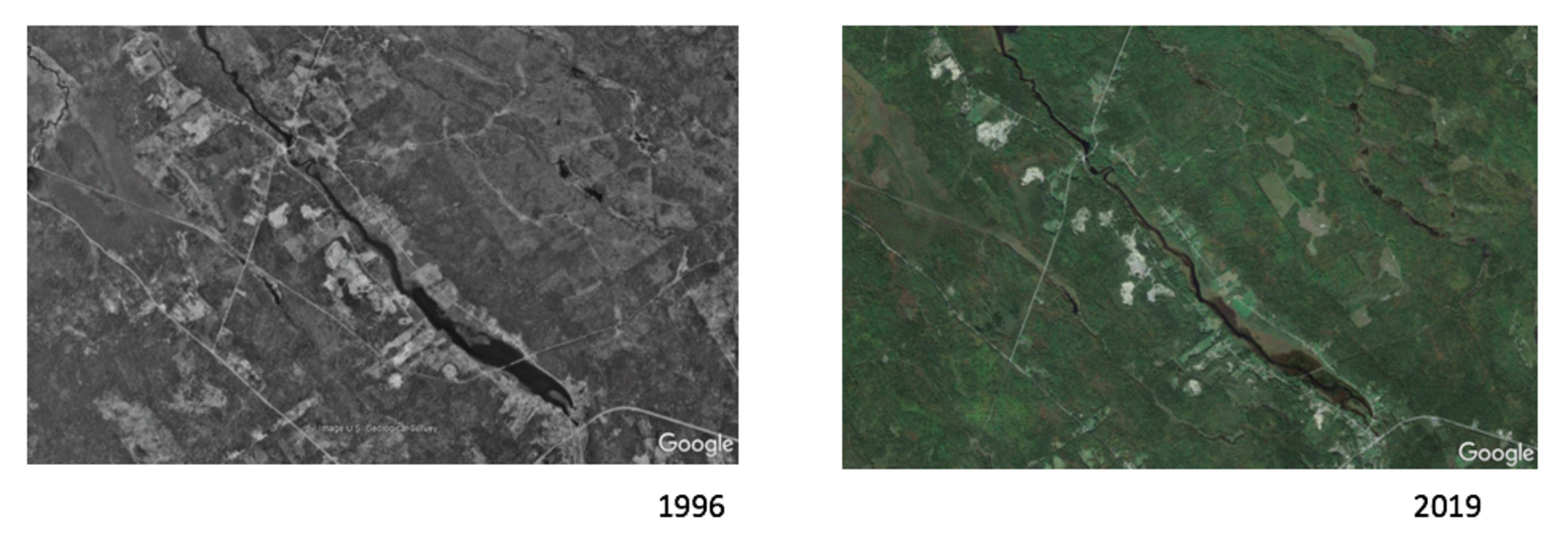 Mapping Environmental Impact of the MineI worked with NASA scientists and scientists associated with the Urban Soils Institute to start to assess the land from satellite. These maps, using Landsat data, visualize the change in land over time and impact on the community's water sources.
Mapping Environmental Impact of the MineI worked with NASA scientists and scientists associated with the Urban Soils Institute to start to assess the land from satellite. These maps, using Landsat data, visualize the change in land over time and impact on the community's water sources. -
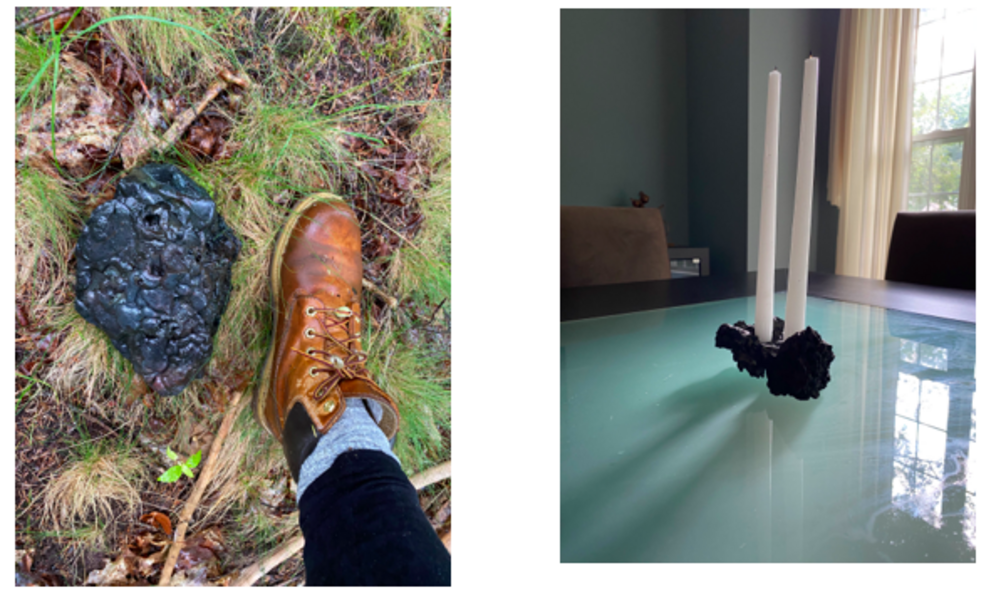 Slag CandlesticksWith slag left over from the Pembroke Iron Works left as a natural resource on the land, I am investigating using it as a material for artworks that can be revenue generating, produced locally by Pembroke citizens, and sold online. I've done exploratory metal forging work with a metal jewelry artist to compose form for the artworks to transform it into bracelets, earrings, and candlesticks as an additional revenue stream for the community.
Slag CandlesticksWith slag left over from the Pembroke Iron Works left as a natural resource on the land, I am investigating using it as a material for artworks that can be revenue generating, produced locally by Pembroke citizens, and sold online. I've done exploratory metal forging work with a metal jewelry artist to compose form for the artworks to transform it into bracelets, earrings, and candlesticks as an additional revenue stream for the community. -
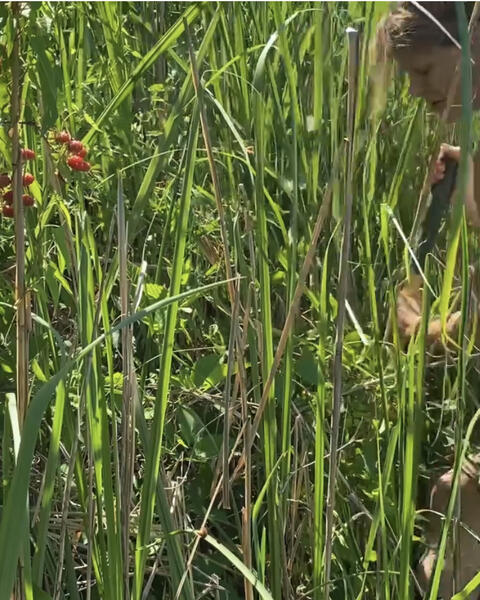 Pry: Washington CollegeIn preparation for indoor and outdoor exhibitions at Washington College in January 2022, I've collaborated with the scientists at the Washington College River and Field Campus to identify site specific environmental issues. At the Chestertown campus, there are three parcels of land that include 230 acres of land that was converted to agriculture then managed plots that could support environmental initiatives like reducing agricultural runoff, improving water quality, and bolstering quail populations. There were cultural tensions between environmental initiatives and local, longstanding agricultural economies. Consequently, the College needed to navigate the conversation with the community to meet immediate needs for the game board while preserving and enhancing the diverse ecosystems. RAFC plays a critical role in community understanding that if there is no balance in the landscape there will be no game and limited water supply. A wide spread intruder along the landscape of the Chestertown River, which borders the RAFC, is the invasive species called the phragmites. With its rhizomatic root, it’s a challenge to combat because mechanical tractors spread the seeds, fire destroys native species, chemicals infiltrate water supply, and removal by hand is laborious. For this exhibition, phragmites were sourced from the shores of the Chestertown River. Phragmites are an invasive species that grow rapidly until they crowd out native plants. By considering the labor involved, both students and the greater community will gain a better understanding of the history and ecology of the Chester River landscape, impact of invasive species, and use of art to frame global environmental justice issues.
Pry: Washington CollegeIn preparation for indoor and outdoor exhibitions at Washington College in January 2022, I've collaborated with the scientists at the Washington College River and Field Campus to identify site specific environmental issues. At the Chestertown campus, there are three parcels of land that include 230 acres of land that was converted to agriculture then managed plots that could support environmental initiatives like reducing agricultural runoff, improving water quality, and bolstering quail populations. There were cultural tensions between environmental initiatives and local, longstanding agricultural economies. Consequently, the College needed to navigate the conversation with the community to meet immediate needs for the game board while preserving and enhancing the diverse ecosystems. RAFC plays a critical role in community understanding that if there is no balance in the landscape there will be no game and limited water supply. A wide spread intruder along the landscape of the Chestertown River, which borders the RAFC, is the invasive species called the phragmites. With its rhizomatic root, it’s a challenge to combat because mechanical tractors spread the seeds, fire destroys native species, chemicals infiltrate water supply, and removal by hand is laborious. For this exhibition, phragmites were sourced from the shores of the Chestertown River. Phragmites are an invasive species that grow rapidly until they crowd out native plants. By considering the labor involved, both students and the greater community will gain a better understanding of the history and ecology of the Chester River landscape, impact of invasive species, and use of art to frame global environmental justice issues.











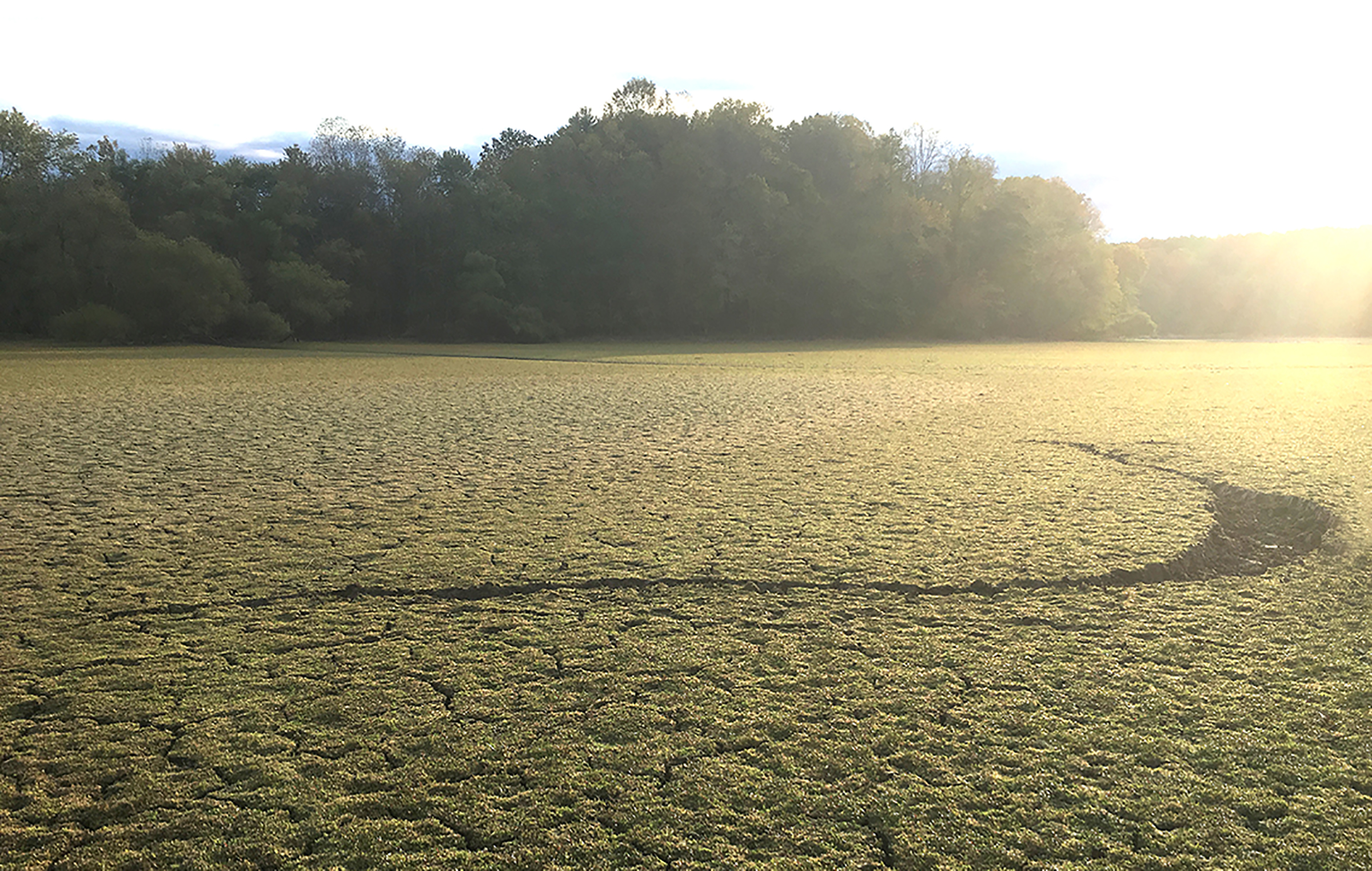




.png)
















